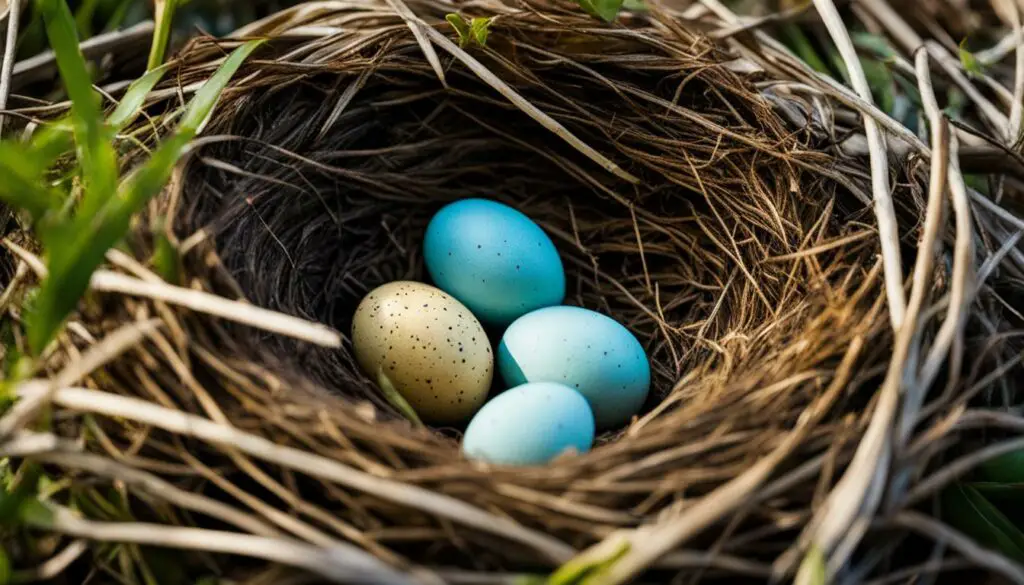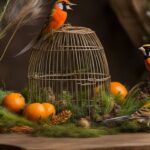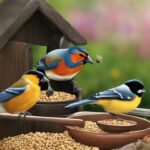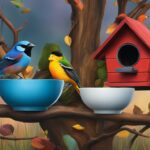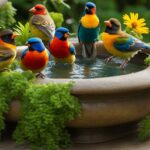Bird egg incubation periods are a fascinating aspect of avian reproduction. From the moment an egg is laid to the hatching of a chirping chick, the journey is filled with wonder and marvel. Let’s dive into the intricacies of bird egg incubation periods and explore the stages of avian embryo development within the safety of a bird nest.
Key Takeaways:
- Bird egg incubation periods are a captivating part of avian reproduction.
- The timing of egg laying varies among bird species, with clutch sizes also differing.
- Bird eggs come in various colors, shapes, and sizes, each with unique characteristics.
- The length of the incubation period varies based on species, environmental conditions, and parental care.
- Parental care plays a vital role in incubating and protecting the eggs during this critical stage.
The Egg Laying Process
When it comes to bird breeding biology, the egg laying process is a pivotal stage in the reproductive cycle. Understanding the hatching time for bird eggs and the intricacies of the egg laying process provides valuable insights into avian reproductive adaptations. Most bird species lay their eggs one or two days after fertilization, but the timing can vary depending on the species. Bald Eagles and Lovebirds, for example, may take longer to lay their eggs.
Clutch sizes also vary among bird species, with some birds nesting and laying eggs only once a year, while others nest multiple times. This diversity in reproductive cycles and behaviors makes studying the egg laying process all the more fascinating. By delving into the different strategies and behaviors of birds during the egg laying stage, we gain a deeper appreciation for the complexities of their breeding biology.
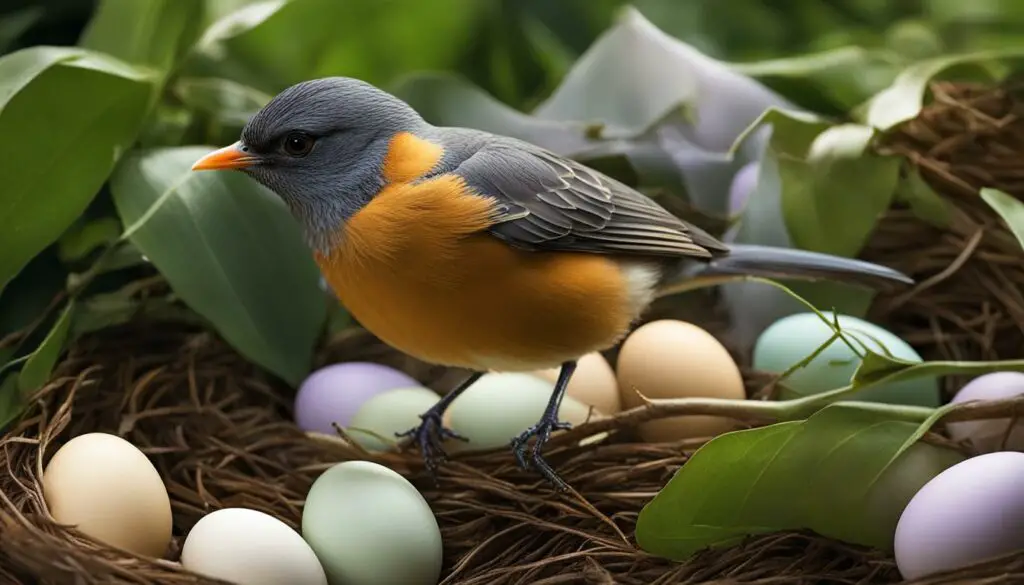
The Egg Laying Process Table
| Bird Species | Incubation Period |
|---|---|
| Bald Eagle | Approximately 35 days |
| Lovebird | Approximately 23 days |
| Ruby-Throated Hummingbird | Approximately 15-18 days |
| Chipping Sparrow | Approximately 10-13 days |
The table above provides a glimpse into the different incubation periods of bird species during the egg laying process. It showcases the variations in hatching time for bird eggs and highlights the differences in incubation duration among species. Understanding these variations helps us appreciate the diverse strategies that birds have evolved to ensure the successful reproduction and survival of their young.
Diversity of Bird Eggs
Bird eggs are truly diverse in their colors, shapes, and sizes. Each bird species has its own unique characteristics when it comes to their eggs, which can provide valuable insights into their reproductive adaptations. From the dull white/tan eggs of the Bald Eagle to the blue/pink eggs of the Blue Jay, the variation in avian eggs is a marvel to behold.
The coloration of bird eggs is often attributed to camouflage and protection. For example, ground-nesting birds tend to have eggs that blend in with their surroundings, while cavity-nesting birds may have eggs that resemble the colors of their nesting cavities. This enables eggs to remain hidden from predators, increasing the chances of successful incubation.
The size of bird eggs can vary significantly depending on the bird species. Larger birds generally have larger eggs, while smaller birds have relatively smaller eggs. This is due to the relationship between egg size and the size of the adult bird. Smaller birds need to lay smaller eggs that can be comfortably incubated and hatched.
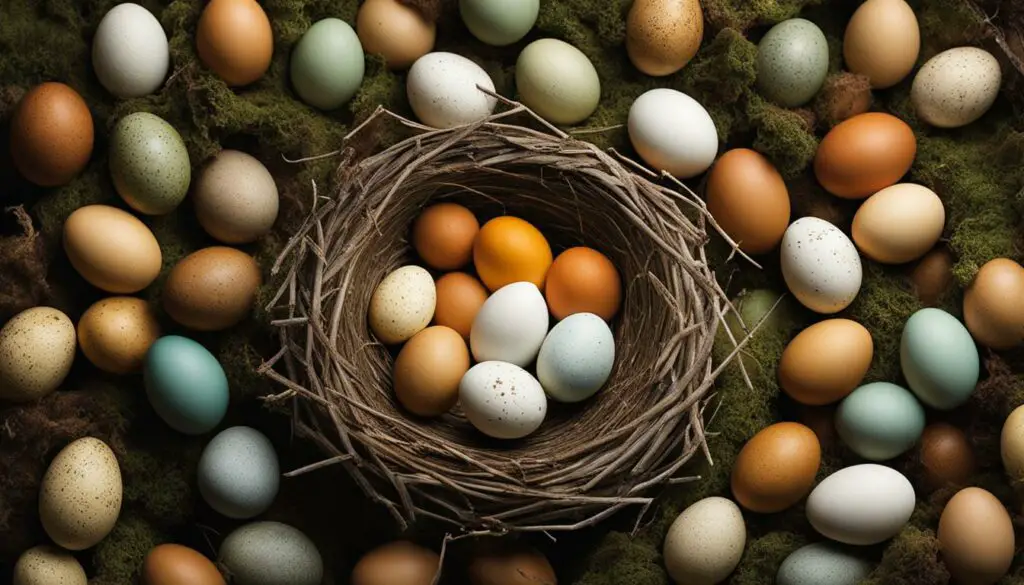
The Incubation Period
The incubation period is a critical stage in the development of bird embryos. During this time, the eggs are kept warm by the parent birds to facilitate healthy growth and development. The length of the incubation period varies depending on the species of bird and other factors such as environmental conditions and parental care. Generally, larger birds tend to have longer incubation periods than smaller birds. It is fascinating to observe the adaptations and strategies that birds employ to ensure the successful incubation of their eggs.
Factors Affecting Incubation Period
- Environmental conditions: The temperature and humidity of the environment can impact the duration of the incubation period. Birds in colder regions may have longer incubation periods to compensate for slower development, while birds in warmer regions may have shorter incubation periods due to faster development.
- Parental care: The level of parental care provided during incubation can influence the length of the incubation period. Some bird species take turns incubating the eggs, while others have one parent responsible for incubation. The level of dedication and attentiveness from the parents can impact the development of the embryos.
- Nest location: The location of the nest can also play a role in the incubation period. Birds that build their nests in safer locations with lower predation risk may have shorter incubation periods. This allows the parents to devote more time to incubation without the need to frequently leave the nest to protect it.
The duration of the incubation period is a remarkable example of avian reproductive adaptations. Different species have evolved specific strategies to ensure the successful incubation of their eggs based on their unique environmental and ecological circumstances. By understanding the factors that influence the incubation period, we can gain deeper insights into the world of bird reproduction and appreciate the remarkable adaptations that have evolved over time.
Table: Incubation Periods of Selected Bird Species
| Bird Species | Incubation Period |
|---|---|
| Ruby-Throated Hummingbird | Approximately 15-18 days |
| Chipping Sparrow | Around 10-13 days |
| Great Blue Heron | Approximately 25-30 days |
| Mallard Duck | Average of 26-30 days |
Note: The incubation periods mentioned above are approximate and can vary depending on various factors.
The Role of Parental Care in Avian Reproduction
Avian reproductive adaptations are fascinating to study, particularly the crucial role of parental care during the incubation period. In bird nesting habits, one or both parent birds take turns incubating the eggs, providing warmth and protection. This dedicated care ensures the healthy development of the embryos and increases the chances of successful hatching.
During the incubation period, the parent birds maintain the optimal temperature and humidity levels in the nest, creating a suitable environment for embryo development. The nest location plays a significant role in avian reproductive adaptations, as birds choose safe and secluded spots to protect their eggs from predators.

The Importance of Shared Incubation
“The dedication and teamwork of parent birds during the incubation period are awe-inspiring. They take turns incubating the eggs, allowing each bird to rest, forage, and engage in other necessary activities. This shared incubation not only benefits the parents but also provides a constant and stable environment for the developing embryos.” – Dr. Jane Peterson, Avian Biologist
While some bird species start incubating after the first egg is laid, others wait until all the eggs are laid. This strategy ensures synchronized hatching, where all the chicks have a similar development stage and compete for parental care and resources equally. The careful coordination between parents during incubation demonstrates the remarkable adaptability of birds in ensuring the survival of their offspring.
| Bird Species | Nest Location | Incubation Period (days) |
|---|---|---|
| Mallard Duck | Near water bodies | 23-30 |
| American Robin | Shrubs, trees | 12-14 |
| Western Grebe | Marshes, lakes | 21-30 |
Table: Incubation periods of different bird species
By understanding the diverse nesting habits and reproductive adaptations of birds, we can develop a deeper appreciation for their dedication and care. The role of parental care in avian reproduction is a testament to the extraordinary lengths birds go to ensure the survival of their species.
Hatching Process
The hatching process is a truly mesmerizing event in the life of a bird. It is the culmination of the long incubation period and the moment when new life emerges from the protective shell. When an egg is ready to hatch, a tiny hole appears on the surface, created by the hatchling’s beak in a process called “pipping.” This hole allows the chick to breathe fresh air. Over the course of several hours, the hatchling continues to chip away at the shell until it finally breaks free and emerges into the world.
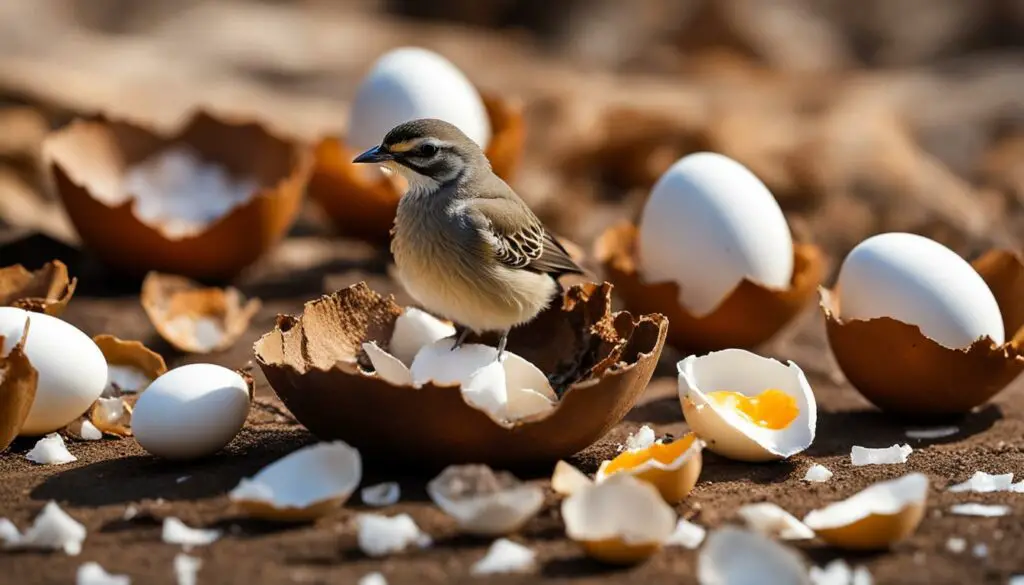
Once the hatchling is out of the egg, it is usually bald or covered in a few soft feathers. At this stage, the mother bird often removes the abandoned eggshell from the nest to make room for the newborn. This act not only keeps the nest clean but also helps reduce the risk of attracting predators with the scent of the discarded shell. The newly hatched chick is vulnerable and dependent on the care and protection of its parent birds.
The hatching process varies among bird species, with some eggs hatching quickly, while others take several hours. The time it takes for a bird egg to hatch depends on various factors, including the size of the egg, the species of bird, and the surrounding environmental conditions. Regardless of the specific duration, witnessing the emergence of a new life is a testament to the wonders of nature and the remarkable adaptations developed by avian species.
Bird Reproductive Behavior and Avian Reproductive Adaptations
Understanding bird reproductive behavior and avian reproductive adaptations is essential for appreciating the complexity of the natural world. Birds employ a range of strategies to ensure the successful reproduction and survival of their offspring. From courtship rituals to nest building and parental care, their behaviors are diverse and fascinating.
One remarkable avian reproductive adaptation is the development of different nest types. Birds construct nests that suit their specific needs and environmental conditions. For example, the intricate nests of weaver birds are meticulously woven from grass, while penguins create nests out of pebbles. These nest-building behaviors not only provide safe and suitable environments for egg incubation but also showcase the ingenuity and adaptive capabilities of birds.
H3: Courtship Rituals
Birds engage in elaborate courtship rituals to attract mates. These rituals often involve displays of plumage, vocalizations, and intricate dances. For example, male birds like the peacock flaunt their vibrant feathers to attract female mates. These courtship behaviors not only serve as a means of communication but also demonstrate the unique reproductive adaptations that have evolved in different bird species.
| Bird Species | Courtship Behavior |
|---|---|
| Peacock | Displays vibrant feathers in a fan-like arrangement |
| Albatross | Performs a complex mating dance with a partner |
| Red-capped Manakin | Engages in synchronized jumping and wing-snapping displays |
“Bird courtship rituals are a beautiful display of nature’s creativity and adaptability.
H3: Parental Care
Once eggs are laid, parent birds provide essential care to ensure proper incubation and the survival of their offspring. Different bird species exhibit varying levels of parental involvement. Some birds take turns incubating the eggs, while others divide responsibilities such as hunting for food and protecting the nest. This division of labor demonstrates the diverse reproductive adaptations that have evolved to meet the specific needs of each bird species.
- Mallard ducks alternate incubation shifts.
- Emperor penguins share incubation duties.
- Bald eagles take turns hunting and guarding the nest.
By exploring bird reproductive behavior and avian reproductive adaptations, we can gain a deeper appreciation for the incredible diversity and complexity of the natural world. From courtship rituals to nest building and parental care, birds demonstrate remarkable strategies and behaviors to ensure the successful continuation of their species.
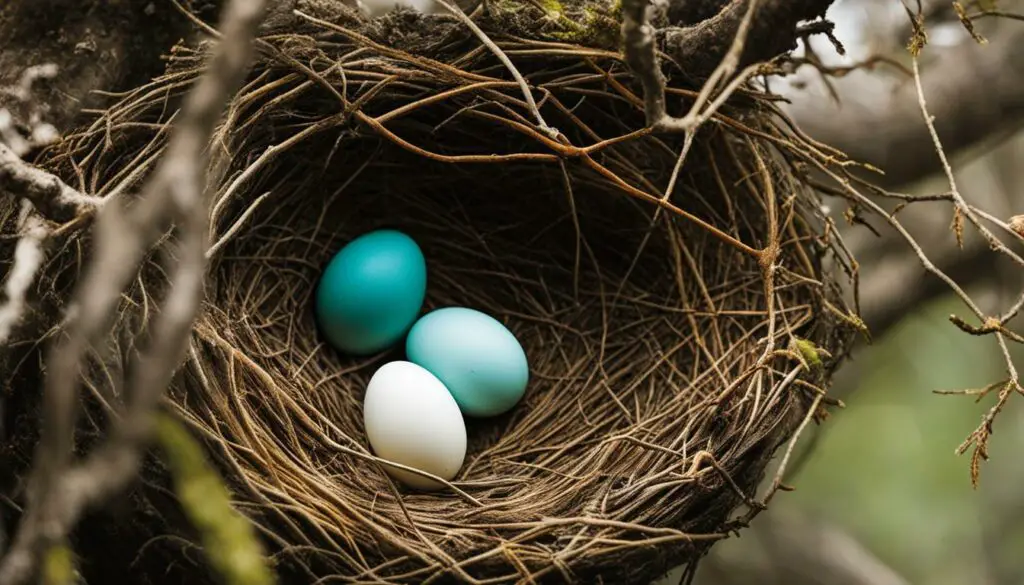
Incubation Periods of Different Bird Species
When it comes to bird egg incubation periods, different bird species have unique durations that suit their reproductive strategies and environmental conditions. Understanding these variations provides valuable insight into bird reproductive behavior and adaptations.
For example, the Ruby-Throated Hummingbird has an incubation period of approximately 15-18 days, while the Chipping Sparrow has a shorter period of around 10-13 days. This difference in duration reflects the specific needs of each species and their ability to adapt to their environment.
Table: Incubation Periods of Different Bird Species
| Bird Species | Incubation Period (days) |
|---|---|
| Ruby-Throated Hummingbird | 15-18 |
| Chipping Sparrow | 10-13 |
Table: Incubation Periods of Different Bird Species
These incubation periods are influenced by various factors such as the size of the bird and its eggs, the environmental conditions, and the bird’s reproductive behavior. Larger birds tend to have longer incubation periods, while smaller birds have shorter ones. Environmental factors like temperature and humidity also play a role, with colder regions often having longer incubation periods to compensate for slower development.
Understanding the range of incubation periods among various bird species allows us to appreciate the diversity and complexity of avian reproduction. It highlights the remarkable adaptations that birds have evolved to ensure the successful hatching of their offspring.
Bird Nesting Habits and Avian Reproductive Adaptations
Understanding the reproductive cycle of birds involves delving into their nesting habits and the remarkable adaptations they have developed over time. These behaviors and adaptations play a crucial role in the successful incubation and hatching of their eggs. By exploring the diverse nesting habits of birds, we can gain insight into the intricate world of avian reproduction.
Nesting Strategies
- Burrow Nesters: Some bird species, such as Burrowing Owls and Kingfishers, create nests in burrows dug into the ground. This nesting strategy provides protection from predators and harsh weather conditions.
- Tree Nesters: Many bird species, including Woodpeckers and Parrots, build nests in tree cavities or construct elaborate structures using twigs and other materials. These nests offer a safe haven for eggs and provide a sturdy foundation for incubation.
- Ground Nesters: Birds like Killdeer and Plovers prefer to nest directly on the ground, often in open areas with minimal vegetation. These nests are typically simple scrapes in the soil, allowing for easy access during incubation.
- Colonial Nesters: Species like Seabirds and Herons form large colonies where many birds nest closely together. This nesting strategy offers protection through numbers, with individuals keeping an eye out for potential threats.
Each nesting strategy has its own set of advantages and challenges, allowing birds to adapt to specific environments and optimize the chances of successful reproduction.
Incubation Techniques
Once the eggs are laid, parent birds employ various techniques to ensure the proper incubation of their offspring:
- Brood Patch: Many bird species develop a specialized patch of bare skin on their abdomen known as the brood patch. This patch allows for direct skin-to-egg contact, transferring the parent’s body heat directly to the developing embryos.
- Incubation Shifts: In species where both parents participate in incubation, they take turns sitting on the eggs. This allows for continuous warmth and reduces the risk of the eggs getting cold or overheated.
- Nest Construction: The materials used to construct the nest can contribute to the incubation process. Nest materials like grass, feathers, and moss provide insulation and help maintain a stable temperature within the nest.
These techniques showcase the remarkable adaptability of birds in ensuring the successful development of their eggs.
| Bird Species | Incubation Period | Nesting Strategy |
|---|---|---|
| Mallard Duck | 23-30 days | Ground Nester |
| House Sparrow | 10-14 days | Tree Nester |
| American Robin | 12-14 days | Tree Nester |
| Atlantic Puffin | 40-45 days | Burrow Nester |
Table: Incubation periods and nesting strategies of selected bird species. The data provides a glimpse into the wide range of incubation periods and the diversity of nesting strategies employed by different bird species.
By studying bird nesting habits and avian reproductive adaptations, we gain a deeper appreciation for the diverse strategies that birds have evolved to ensure the survival of their species. From the choice of nesting location to the incubation techniques employed, these adaptations showcase the remarkable complexity and ingenuity of nature.
The Importance of Nest Location
When it comes to bird nesting habits and avian reproductive adaptations, the location of the nest plays a crucial role. The choice of nest location can significantly impact the incubation period of bird eggs. Birds that build their nests in safer locations with lower predation risk may have shorter incubation periods. This is because the parents can devote more time to incubation without leaving the nest frequently to protect it. On the other hand, birds that nest in exposed or vulnerable locations may have longer incubation periods as they need to take extra precautionary measures.
For example, birds that construct their nests high in trees or cliffs are often safer from predators like ground-dwelling mammals. The increased height provides better visibility and makes it more challenging for predators to reach the nest. As a result, these birds can have shorter incubation periods, allowing the eggs to develop and hatch more quickly.
In contrast, birds that nest on the ground or in open areas may have longer incubation periods. They need to spend more time away from the nest, either foraging for food or keeping a watchful eye for potential threats. This increased incubation time ensures that the eggs receive sufficient warmth and protection while the parents are away.

The importance of nest location in the context of avian reproductive adaptations cannot be overstated. It is a key factor in the successful breeding and survival of bird species. By choosing the right location for their nests, birds can optimize the conditions for incubation and increase the chances of successful hatching. As bird enthusiasts and conservationists, understanding the significance of nest location allows us to support and protect these vital habitats, ensuring the continued well-being of our feathered friends.
Bird Species and Their Eggs
Each bird species has its own unique characteristics when it comes to their eggs. From the small, white eggs of the Ruby-Throated Hummingbird to the pale blue eggs of the Eastern Bluebird, bird eggs exhibit a wide range of colors, sizes, and markings. These variations in egg characteristics provide valuable insights into the reproductive behavior and adaptations of different bird species.
The size, color, and markings of bird eggs can vary greatly, reflecting the specific needs and strategies of each species. For example, ground-nesting birds like the Killdeer have speckled eggs that blend with their surroundings, providing camouflage and protection against predators. In contrast, tree-nesting birds like the American Robin have blue eggs that stand out against the green foliage, possibly attracting mates or signaling reproductive readiness.
Additionally, the shape and size of bird eggs can also vary. Some birds, like owls and pigeons, lay round or elliptical eggs, while others, like falcons and hawks, lay more conical-shaped eggs. These variations in egg shape may be influenced by the bird’s nesting habits, with certain shapes better suited for specific nest types or environments.
| Bird Species | Egg Color | Egg Size | Egg Markings |
|---|---|---|---|
| Ruby-Throated Hummingbird | White | Approximately 0.5 inches | No markings |
| Eastern Bluebird | Pale blue | Approximately 1 inch | No markings |
| Killdeer | Speckled | Approximately 2 inches | Camouflage patterns |
| American Robin | Blue | Approximately 1.2 inches | No markings |
“The diversity in bird egg characteristics is a testament to the incredible adaptability and evolutionary strategies of avian species. By studying these variations, we can gain a deeper understanding of the behaviors and adaptations that have allowed birds to successfully reproduce and thrive in their respective habitats.” – Dr. Jane Anderson, Ornithologist
As fascinating as bird eggs are, it’s important to remember that they serve a vital purpose in the continuation of species. They represent the potential for new life and the future survival of bird populations. By appreciating the diversity and uniqueness of bird eggs, we gain a greater appreciation for the intricate world of avian reproductive behavior and the wonders of nature.
Appreciating the Journey
Bird egg incubation periods offer a window into the fascinating world of avian embryo development and the intricate processes of the bird reproductive cycle. From the moment an egg is laid to the hatching of a chick, every step in this journey is a testament to nature’s wonders. By delving into the intricacies of bird egg incubation, we can deepen our connection with the natural world and gain a greater appreciation for the beauty and complexity of avian life.
Throughout the incubation period, the unborn chicks experience incredible changes and development. From the delicate formation of organs to the growth of feathers, each stage of avian embryo development is a marvel in its own right. The eggs carefully cradled in bird nests hold the promise of new life, and it is awe-inspiring to witness the transformation that occurs within them.
As we explore the journey of bird egg incubation, we gain insight into the diverse strategies and adaptations of different bird species. From the variety of egg colors and shapes to the nesting habits and parental care undertaken, birds have evolved a range of behaviors to ensure the survival of their offspring. By observing and understanding these adaptations, we gain a deeper understanding of the intricate web of life that exists in our natural world.
| Avian Embryo Development Stages | Description |
|---|---|
| Fertilization | The male bird’s sperm fertilizes the female bird’s egg after mating. |
| Incubation | The parent birds provide heat to the eggs, ensuring proper development. |
| Hatching | The chick breaks through the shell, emerging into the world. |
By appreciating the journey of bird egg incubation, we gain a deeper understanding of the wonders of nature and the resilience of avian life. It is a reminder of the intricate processes that occur all around us, often unnoticed, and inspires us to cherish and protect the delicate balance of our natural world.
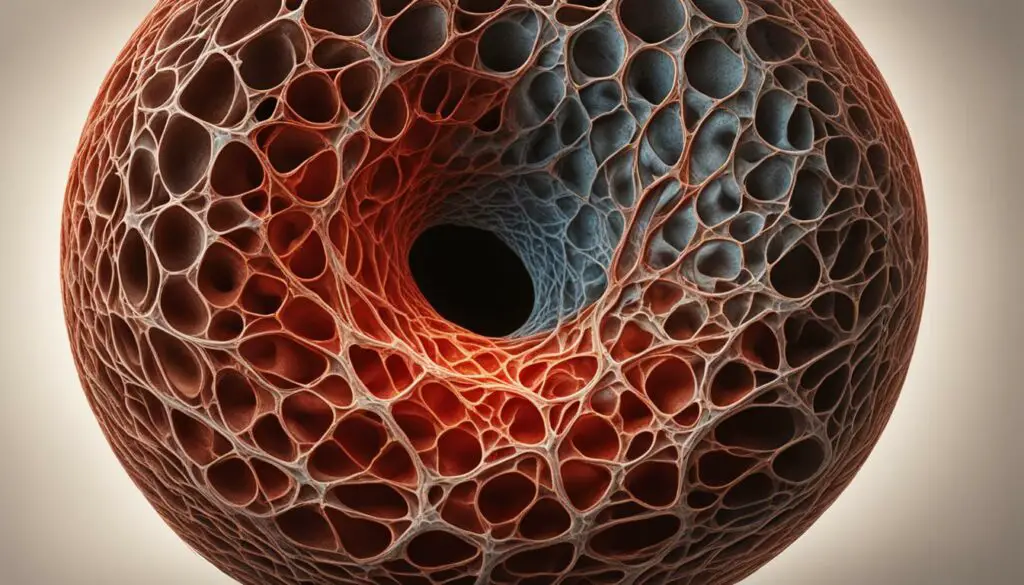
The Fascinating World of Avian Reproduction
Bird breeding biology and avian reproductive adaptations offer a captivating glimpse into the intricate world of avian reproduction. From the diverse strategies employed by different bird species to the remarkable adaptations that ensure the survival of their offspring, exploring this fascinating realm deepens our understanding of nature’s wonders.
One of the key aspects of avian reproduction is bird breeding biology. Each bird species has its own unique reproductive cycles, behaviors, and adaptations that contribute to successful breeding. From the timing of egg laying to the role of parental care, every stage offers insight into the remarkable strategies birds have developed over millions of years.
Avian reproductive adaptations further highlight the ingenuity of nature. The length of the incubation period, for example, varies across bird species and is influenced by factors such as environmental conditions and nest location. Birds have evolved to adapt to their specific habitats, ensuring the optimal development and hatching of their eggs.
Table 1: Comparative Incubation Periods of Selected Bird Species
| Bird Species | Incubation Period |
|---|---|
| Ruby-Throated Hummingbird | 15-18 days |
| Chipping Sparrow | 10-13 days |
| Bald Eagle | 35-40 days |
Understanding bird breeding biology and avian reproductive adaptations not only enriches our knowledge of these incredible creatures but also highlights the importance of conservation efforts. By appreciating the marvels of avian reproduction, we can become advocates for protecting nesting habitats, promoting responsible birdwatching practices, and ensuring the continued survival of bird species for generations to come.
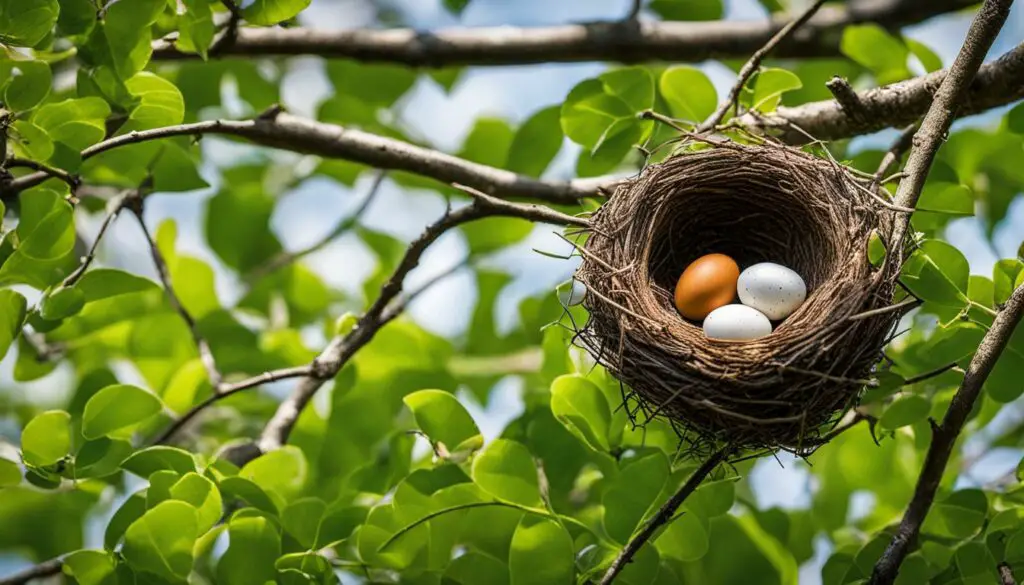
Join me in exploring the awe-inspiring world of avian reproduction and discover the hidden wonders of bird breeding biology and avian reproductive adaptations.
Bird Enthusiasts and Conservation
Bird enthusiasts are passionate about birds and play a crucial role in their conservation and protection. By understanding the intricacies of bird reproductive behavior and avian reproductive adaptations, enthusiasts can contribute to preserving nesting habitats and ensuring the survival of bird species. Their knowledge and observations provide valuable insights into the reproductive cycles and behaviors of birds, which can inform conservation strategies and efforts.
One way bird enthusiasts contribute to conservation is by promoting responsible birdwatching practices. They understand the importance of minimizing disturbance to nesting birds, especially during the vulnerable incubation period. By following ethical guidelines, such as keeping a distance from nests and not approaching or handling eggs or chicks, birdwatchers help safeguard the well-being of bird populations.
Conservation organizations rely on the contributions and support of bird enthusiasts to carry out conservation initiatives. These organizations work towards protecting and restoring vital habitats, implementing conservation projects, and advocating for policies that benefit birds and their habitats. Birdwatchers often participate in citizen science programs, reporting their observations and contributing data that helps scientists monitor bird populations, track breeding success, and identify potential threats.
| Conservation Contributions of Bird Enthusiasts | Conservation Organizations |
|---|---|
| • Promoting responsible birdwatching practices | • Protecting and restoring habitats |
| • Contributing data through citizen science programs | • Implementing conservation projects |
| • Supporting conservation initiatives | • Advocating for policies benefiting birds |
Birdwatchers also have a role in raising awareness about the importance of avian conservation. Through their passion and knowledge, they inspire others to appreciate birds and their habitats, fostering a sense of connection with nature. By sharing their experiences, photographs, and stories, bird enthusiasts can engage a wider audience and encourage conservation-minded actions, such as creating bird-friendly gardens, supporting local conservation efforts, and learning about the challenges birds face in a changing world.
As the saying goes, “We protect what we love.” Bird enthusiasts embody this sentiment, dedicating their time, resources, and energy to safeguarding the beauty and diversity of bird species. Their passion for birds and commitment to conservation ensure that future generations can continue to marvel at the wonders of avian reproductive adaptations and behaviors.
Conclusion
As I conclude this exploration into bird egg incubation periods and avian embryo development, I am filled with awe and admiration for the wonders of nature. From the moment an egg is laid to the hatching of a chirping chick, the journey is a testament to the intricate reproductive cycles of bird species.
Throughout this article, we have delved into the fascinating world of avian reproduction, unraveling the diverse strategies and adaptations of bird species. We have discovered the different incubation periods of various bird species, ranging from the Ruby-Throated Hummingbird’s 15-18 days to the Chipping Sparrow’s 10-13 days.
Furthermore, we have examined the vital role of parental care during the incubation period, the remarkable hatching process, and the distinction between altricial and precocial birds. We have also explored the influence of environmental factors and nest location on incubation periods, as well as the diverse characteristics of bird eggs.
By appreciating the unique journey of bird egg incubation, we can deepen our connection with the natural world. Understanding the intricacies of avian reproduction not only enhances our knowledge but also inspires us to become stewards of the environment and advocates for bird conservation.
FAQ
How long do bird eggs take to hatch?
The incubation period varies between bird species, but generally ranges from a few weeks to a month.
Do all birds lay eggs?
Yes, all bird species lay eggs as part of their reproductive process.
How many eggs does a bird lay at a time?
The number of eggs laid by a bird species can vary, with some birds laying only one or two eggs at a time, while others may lay larger clutches.
How do birds keep their eggs warm during incubation?
Parent birds take turns incubating the eggs, providing warmth and protection through body heat.
What happens after the eggs hatch?
After hatching, parent birds continue to care for and feed their chicks until they are ready to leave the nest.
Are all bird hatchlings born helpless?
No, some bird species are born more developed and can walk or swim shortly after hatching, while others are born bald and dependent on their parents for food and warmth.
How long does it take for a baby bird to fledge?
The time it takes for a baby bird to fledge, or leave the nest, varies between species but can range from a few weeks to a couple of months.
Do different bird species have different incubation periods?
Yes, each bird species has its own unique incubation period that suits its specific reproductive strategy and environmental conditions.
How do environmental factors affect bird egg incubation?
Temperature and humidity can impact the duration of the incubation period, with birds in colder regions often having longer incubation periods.
Why is nest location important for bird eggs?
Nest location can affect the incubation period of bird eggs, with safer locations often resulting in shorter incubation periods due to reduced predation risk.
Do all bird eggs look the same?
No, bird eggs come in a variety of colors, sizes, and markings, with each bird species having its own unique characteristics when it comes to their eggs.
What can we learn from studying bird egg incubation periods?
Studying bird egg incubation periods provides valuable insights into bird reproductive behavior, adaptations, and the diversity of avian species.
How can bird enthusiasts support bird conservation?
Bird enthusiasts can contribute to bird conservation efforts by protecting nesting habitats, practicing responsible birdwatching, and supporting conservation organizations.
Why is avian reproduction fascinating?
Avian reproduction is fascinating because it showcases nature’s wonders and the intricate processes that birds go through to ensure the survival of their offspring.
What is the significance of bird egg incubation periods?
Bird egg incubation periods are a crucial stage in avian embryo development and provide insights into the breeding biology and adaptations of different bird species.

